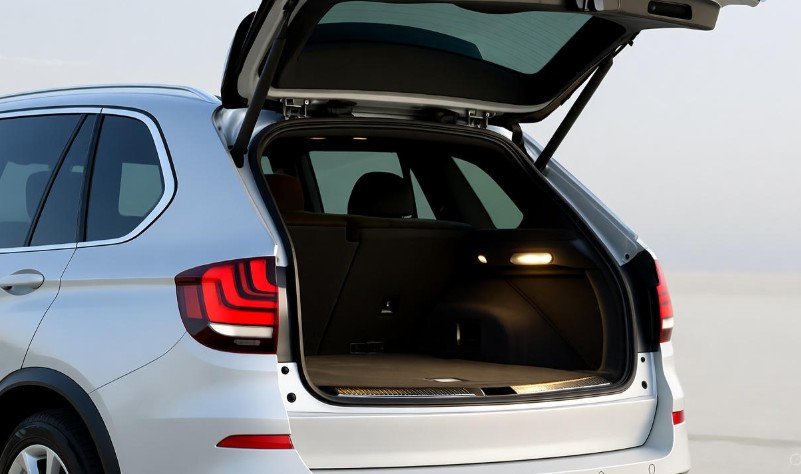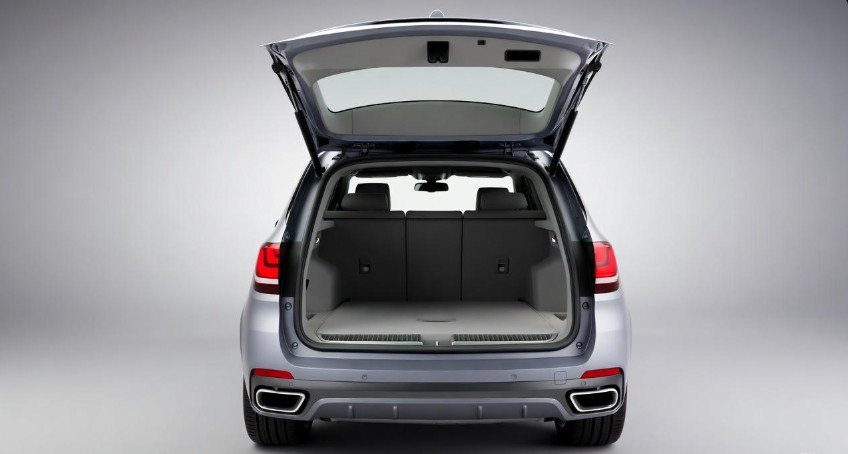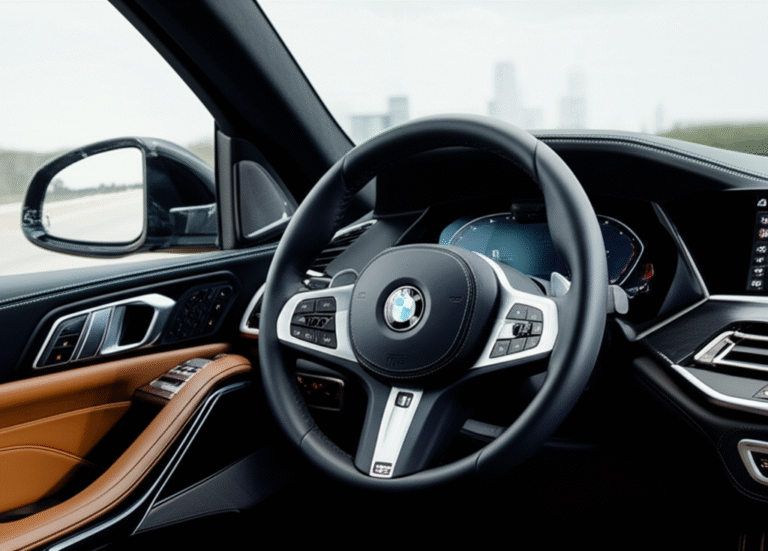BMW X5 Boot Dimensions: 5 Facts

BMW X5 boot dimensions are crucial for fitting luggage, gear, or groceries, offering a versatile space that balances luxury with practicality. Understanding these dimensions ensures you can confidently transport your essentials.
In This Article
- 1 Key Takeaways
- 2 Unlock Your Cargo Potential: 5 Critical BMW X5 Boot Dimensions Facts
- 2.1 Fact 1: Unveiling Raw Cargo Volume – The Numbers Game
- 2.2 Fact 2: Navigating the Dimensions – Width, Depth, and Height
- 2.3 Fact 3: The Impact of Optional Features and Configurations
- 2.4 Fact 4: Understanding the Two-Part Tailgate – A Blessing and a Curse?
- 2.5 Fact 5: Practical Loading Tips and Cargo Management
- 3 Frequently Asked Questions About BMW X5 Boot Dimensions
- 3.1 What is the standard cargo capacity of a BMW X5?
- 3.2 How much cargo space is available when the rear seats are folded down in a BMW X5?
- 3.3 Does the BMW X5 have enough boot space for golf clubs?
- 3.4 Are there different boot dimensions for gasoline vs. diesel BMW X5 models?
- 3.5 Can a BMW X5 fit a large refrigerator or furniture in its boot?
- 3.6 How does the optional third-row seating affect the BMW X5’s boot space?
- 4 Conclusion
Key Takeaways
- Measure your cargo to confirm fit.
- Compare X5 generations for dimension differences.
- Consider the X5’s overall size and use case.
- Utilize cargo management accessories for efficiency.
- Check official BMW specifications for accuracy.
When you’re looking at a luxury SUV like the BMW X5, you’re not just thinking about performance and style. You’re also thinking about how it fits into your life. How much can you actually carry in it? This is where understanding the BMW X5 boot dimensions becomes incredibly important. Whether you’re packing for a family road trip, heading out for a weekend of adventure sports, or just doing your weekly grocery run, knowing the cargo space available will make all the difference. Many drivers find themselves guessing or hoping their gear will fit. We’re here to simplify that. Let’s dive into five essential facts about the BMW X5 boot dimensions that every buyer and owner should know, ensuring you can confidently load up and go.
Unlock Your Cargo Potential: 5 Critical BMW X5 Boot Dimensions Facts

The BMW X5 has long been a benchmark in the mid-size luxury SUV segment, celebrated for its blend of dynamic driving and opulent comfort. But beyond the plush leather seats and advanced infotainment system lies a crucial aspect for everyday usability: the cargo area, commonly referred to as the boot. For many, the ability to haul gear, luggage, or shopping is just as important as the driving experience itself. Understanding the BMW X5 boot dimensions is key to making an informed decision, whether you’re buying new, used, or simply planning your next trip.
Fact 1: Unveiling Raw Cargo Volume – The Numbers Game
The core of any boot discussion boils down to its capacity. The BMW X5 typically offers a generous amount of space, but these figures can vary slightly depending on the model year and specific configuration. For the most recent generations, you can expect the BMW X5 boot to offer around 22.9 cubic feet (approximately 649 liters) of space with all seats in their upright position. This is a substantial area, capable of swallowing multiple suitcases, a good portion of a weekly shop, or sports equipment for a few people.
Behind the Numbers: What Does This Mean for You?
Imagine loading up for a long weekend getaway. With 22.9 cubic feet, you can comfortably fit two to three large checked suitcases, plus a couple of carry-on bags and a weekend duffel. For families, this means less Tetris-like packing and more ease when getting everyone and everything to the airport or vacation spot. If you’re a golfer, you can likely fit at least two golf bags with their trolleys, though you might need to angle them strategically. This raw volume is the foundation of the X5’s utility.
The Split Rear Seat Advantage
A key feature enhancing the practical volume of the BMW X5 boot is its folding rear seat capability. Most X5 models come with a 40:20:40 split-folding rear seat configuration. This flexibility allows you to transport longer items – like skis, a lumber plank, or a surfboard – by folding down just the center section, while still accommodating passengers in the outer seats. When you fold down all the rear seats, the cargo capacity expands significantly. For the latest models, this expands the space to approximately 72.3 cubic feet (around 2,048 liters). This transformed space is comparable to many smaller cargo vans, offering remarkable versatility for larger hauls.
Here’s a quick comparison of the cargo volume across recent BMW X5 generations:
| Model Generation | Years | Cargo Volume (Seats Up) | Cargo Volume (Seats Down) |
|---|---|---|---|
| G05 (Current Generation) | 2019–Present | 22.9 cu ft (649 L) | 72.3 cu ft (2,048 L) |
| F15 | 2014–2018 | 23.3 cu ft (660 L) | 66.0 cu ft (1,865 L) |
| E70 | 2007–2013 | 25.7 cu ft (728 L) | 61.9 cu ft (1,752 L) |
Remember, these are official figures, but real-world usability can feel different based on the shape of your items and how efficiently you pack them.
Beyond total volume, the actual physical dimensions of the boot – its width, depth, and height – are critical for fitting specific items. While BMW doesn’t always publish these granular measurements publicly for every model year, general insights are available and can be inferred from the overall vehicle design.
Interior Width and Loading Lip Height
The width between the wheel arches is a common constraint in many vehicles, and the X5 is no exception. Expect the usable width to be slightly less than the maximum interior width of the cargo area. For most X5 models, this internal width is around 40-44 inches (100-112 cm). The height from the boot floor to the retracted parcel shelf is typically in the region of 20-24 inches (50-60 cm). The loading lip height, which is the distance from the ground to the top of the bumper where you load items, is usually around 30-32 inches (76-81 cm). This height is important for ease of loading, especially for heavier items, and can be a factor for individuals with mobility concerns.
Maximum Depth and Tailgate Opening
The maximum depth of the boot, measured from the back of the rear seats to the tailgate, is considerably larger when the seats are folded down. With the rear seats up, you might have a depth of around 40 inches (102 cm). With the rear seats folded, this depth can extend to over 70 inches (178 cm), allowing for much larger items to be slid in. The shape of the tailgate opening also plays a role. The X5 features a distinctive two-part tailgate (a split tailgate on older models, and a power liftgate and separate dropping tailgate on newer ones). This design can be beneficial for loading long items, or for creating a makeshift stage for tailgating, but it also means the opening might not be as uniformly tall or wide at its narrowest point as a single-piece tailgate.
Pro Tip: Always bring a tape measure when you’re planning to haul something specific, especially for the first time. Measure your item and then compare it to the available space, paying attention to the narrowest points.
Fact 3: The Impact of Optional Features and Configurations
When you’re configuring a new BMW X5 or examining a used one, certain optional features can subtly impact the boot dimensions or its perceived usability. While the core volume figures remain consistent, these additions can change how you utilize the space.
Third-Row Seating
Some BMW X5 models, particularly those designed for potentially larger families or for specific markets, offer an optional third row of seating. If your X5 is equipped with this feature, it significantly reduces the boot space when the third row is in use. The cargo volume behind the third row is typically much smaller, often in the range of 10-15 cubic feet (280-420 liters), which is comparable to a compact car’s boot. If you frequently need both the third row and substantial cargo space, the X5 might be a compromise, and you might need to consider folding the third row down to maximize boot capacity, limiting passenger count. Always verify if a specific X5 model has the third-row option if cargo space is a top priority.
Optional Cargo Management Systems
BMW offers various optional cargo management systems designed to enhance the functionality of the X5’s boot. These can include floor rails with securing nets, cargo organizers, or dividing systems. While these accessories don’t reduce the overall volume, they can take up a small amount of space and, more importantly, influence how you can arrange your items. For example, a cargo net system might slightly reduce the overall height you can utilize if it’s permanently installed and takes up vertical room.
Spare Tire vs. Run-Flat Tires
Historically, many BMWs, including the X5, came equipped with run-flat tires as standard. This often meant that there was no need for a spare tire, freeing up space underneath the boot floor. However, some models or configurations might still include a spare tire or a tire repair kit. The presence or absence of a spare tire can affect the depth and usability of the underfloor storage compartment within the boot. If you’re buying a used X5, check what’s included and how it impacts the available space.
Fact 4: Understanding the Two-Part Tailgate – A Blessing and a Curse?
The BMW X5 is known for its distinctive two-part tailgate, which consists of a lower, dropping tailgate and an upper liftgate. This design has been a hallmark of the X5 for several generations and offers both advantages and disadvantages regarding boot access and dimensions.
Advantages of the Two-Part Tailgate
- Easier Loading: The lower tailgate drops down, creating a lower loading lip. This makes it easier to slide heavier or bulkier items into the boot without having to lift them as high.
- Convenience: When partially open, the lower tailgate can act as a convenient surface for placing items temporarily while you load the rest of your cargo, or it can serve as a perch for sitting.
- Reduced Load Height: The lower opening means you don’t have to lift items over as high a lip, which is particularly beneficial for those with back issues or when loading sports equipment like bicycles or kayaks (though these would likely require the upper gate to be fully open).
Disadvantages of the Two-Part Tailgate
- Height Restriction: While the overall cargo height is good, the opening formed by just the upper liftgate can be less tall than a conventional single tailgate. If you need to load something very tall and narrow, it might be more of a squeeze.
- Complexity: Some drivers find the operation of two separate tailgate sections slightly more complex than a single liftgate.
- Weather Exposure: When the lower tailgate is down, it exposes the boot contents to the elements more than a single tailgate would in a similar partial open state.
For the latest generation (G05), BMW has moved towards a more conventional powered liftgate for the main tailgate, but the dropping lower section often remains, offering a blend of both designs. Always check the specific model you are interested in, as features can evolve. For more on BMW’s engineering innovations, you can explore resources from official BMW sites or reputable automotive engineering publications.
Fact 5: Practical Loading Tips and Cargo Management
Knowing the BMW X5 boot dimensions is one thing; efficiently using that space is another. Smart loading and utilizing cargo management accessories can maximize your ability to carry what you need.
Packing Strategy
Whenever possible, pack heavier items towards the center of the boot and closer to the rear seats. This helps with weight distribution and vehicle balance, which is crucial for safety and handling, especially in a performance-oriented SUV like the X5. Utilize soft bags (duffels, backpacks) wherever possible, as they can conform to irregular spaces better than rigid suitcases. If you have multiple suitcases, try to fit smaller ones inside larger ones.
Cargo Nets and Organizers
A vertical cargo net, often available as an accessory from BMW or third-party manufacturers, can be invaluable. It attaches to the sides of the boot and can prevent items from sliding forward under braking or acceleration. Horizontal cargo nets or dividers can help segment the boot, keeping different types of items separate and secure. Many X5 models have tie-down points or anchor rings in the boot floor and sides, which are perfect for securing larger or irregularly shaped items with bungee cords or straps.
Maximizing Vertical Space
The parcel shelf can be removed to gain additional vertical space, allowing you to stack items higher. Be mindful of the vehicle’s weight capacity if you’re loading it to the roof. For items that need to be kept separate or upright, consider using sturdy plastic bins or containers that can be stacked and secured with cargo nets.
Loading Heavy Items Safely
When loading heavy items, especially into the larger boot space created by folding down the rear seats, ensure you have adequate assistance. Use the dropped lower tailgate (if applicable) to reduce the lifting height. Always ensure items are secured and won’t shift during transit. For very large or awkward items, consider if they can be transported more easily in a different vehicle or with professional services. For guidance on vehicle load limits, consult your vehicle’s owner’s manual or official National Highway Traffic Safety Administration (NHTSA) resources on tire safety and load capacity.
Frequently Asked Questions About BMW X5 Boot Dimensions
What is the standard cargo capacity of a BMW X5?
The standard cargo capacity of a BMW X5, with all rear seats in use, is generally around 22.9 cubic feet (649 liters) for recent models. This can vary slightly by generation.
How much cargo space is available when the rear seats are folded down in a BMW X5?
When the rear seats are folded down in a BMW X5, the cargo capacity expands significantly, typically to around 72.3 cubic feet (2,048 liters) for current generations. This offers substantial space for larger items.
Does the BMW X5 have enough boot space for golf clubs?
Yes, the BMW X5 generally has enough boot space to accommodate golf clubs. With the rear seats up, you can usually fit two golf bags longitudinally. If you need to fit more or larger bags, folding down the rear seats provides ample room.
Are there different boot dimensions for gasoline vs. diesel BMW X5 models?
While the overall exterior dimensions of the X5 are consistent between gasoline and diesel variants of the same generation, there can be minor differences in internal boot dimensions due to variations in underfloor components or exhaust systems. However, these differences are typically negligible and don’t significantly impact practical cargo capacity.
Can a BMW X5 fit a large refrigerator or furniture in its boot?
With the rear seats folded down, the BMW X5 offers a large, flat cargo area that can accommodate many types of furniture or appliances. However, very large items like a full-size side-by-side refrigerator might be a tight fit or impossible due to the height and width of the opening. It’s always best to measure your item and compare it to the maximum cargo depth and height with seats folded.
How does the optional third-row seating affect the BMW X5’s boot space?
If a BMW X5 is equipped with optional third-row seating, the boot space behind the third row is considerably reduced, typically to around 10-15 cubic feet (280-420 liters). This configuration is best suited for smaller families who occasionally need the extra seating and can forgo significant cargo capacity. Folding the third row and second row then restores a much larger cargo area.
Conclusion
The BMW X5 is more than just a luxury vehicle; it’s a practical companion designed to handle the demands of modern life. Understanding its boot dimensions – from the raw cubic feet available to the precise measurements and the nuances of its tailgate design – is essential for maximizing its utility. Whether you’re a seasoned road-tripper, a weekend adventurer, or a busy parent, these five facts should equip you with the knowledge to confidently pack your X5 for any journey. By considering the cargo volume, physical dimensions, optional features, tailgate practicality, and employing smart loading strategies, you can ensure your BMW X5 serves you perfectly, blending its renowned luxury with exceptional everyday versatility.






